



Time-dependent Structure of Perturbed Relativistic Jets interprets an extended set of these simulations using a linear normal modes analysis. The observed structures and differences between structure in the different simulations are found to be fully understandable in terms of the structure and growth or damping of the normal axisymmetric Fourier modes of a cylindrical jet.
A Comparison of the Morphology and Stability of Relativistic and Nonrelativistic Jets extends the simulations and their analysis in Lorentz factor--Mach number--temperature space, compares the morphology of Relativistic and Nonrelativistic flows, and applies the modeling to the source Cygnus A. The primary result of these comparisons is that the velocity field of nonrelativistic jet simulations cannot be scaled up to give the spatial distribution of Lorentz factors seen in relativistic simulations. Since the local Lorentz factor plays a major role in determining the total intensity for parsec-scale extragalactic jets, this suggests that a nonrelativistic simulation cannot yield the proper intensity distribution for a relativistic jet.
 Relativistic Jet Response to Precession and Wave-Wave Interactions
explores the response of a Lorentz factor 2.5 relativistic jet to precession
at three different frequencies relative to the maximally unstable frequency
predicted by a Kelvin-Helmholtz stability analysis. Wave (pattern) speeds
range from 0.41c to 0.86c, but the beat patterns remain stationary. Thus,
we find a mechanism that can produce differentially moving and stationary
features in a jet.
Relativistic Jet Response to Precession and Wave-Wave Interactions
explores the response of a Lorentz factor 2.5 relativistic jet to precession
at three different frequencies relative to the maximally unstable frequency
predicted by a Kelvin-Helmholtz stability analysis. Wave (pattern) speeds
range from 0.41c to 0.86c, but the beat patterns remain stationary. Thus,
we find a mechanism that can produce differentially moving and stationary
features in a jet.
The paper 3D Hydrodynamic Simulations of Relativistic Extragalactic Jets describes the study the deflection and precession of relativistic flows. Even quite fast jets can be significantly influenced by impinging on an oblique density gradient, exhibiting a rotation of the Mach disk and potentially strong, oblique internal shocks, while under a large amplitude precession, the collimated flow is disrupted after 50 jet-radii. Significantly enhanced flow emission may be associated with deflection shocks, and the convolution of rest frame emissivity and Doppler boost in the case of the precessed jet invariably leads to a core-jet-like structure.
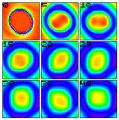 In
The Effect of External Winds on Relativistic Jet, we find considerable
stabilization of relativistic jet flow by a wind to helical and higher order
asymmetric modes of jet distortion. Reduction in the absolute velocity
difference between jet and wind provides stabilization in addition to
stabilization provided by a high jet Lorentz factor, but a high Lorentz
factor wind is not needed to stabilize a high Lorentz factor jet. However,
the fundamental pinch mode is not similarly affected, and knots with spacing
a few times the jet radius are anticipated to develop in such flows. Thus, we
identify a mechanism that can suppress large-scale asymmetric structures
while allowing axisymmetric structures to develop. Jets like that in 3C 175
could be triggered by pinching of an initially low Mach number jet surrounded
by a suitable wind. As the jet enters the radio lobe, suppression of any
surrounding outflow or backflow associated with the high-pressure lobe
triggers exponential growth of helical twisting.
In
The Effect of External Winds on Relativistic Jet, we find considerable
stabilization of relativistic jet flow by a wind to helical and higher order
asymmetric modes of jet distortion. Reduction in the absolute velocity
difference between jet and wind provides stabilization in addition to
stabilization provided by a high jet Lorentz factor, but a high Lorentz
factor wind is not needed to stabilize a high Lorentz factor jet. However,
the fundamental pinch mode is not similarly affected, and knots with spacing
a few times the jet radius are anticipated to develop in such flows. Thus, we
identify a mechanism that can suppress large-scale asymmetric structures
while allowing axisymmetric structures to develop. Jets like that in 3C 175
could be triggered by pinching of an initially low Mach number jet surrounded
by a suitable wind. As the jet enters the radio lobe, suppression of any
surrounding outflow or backflow associated with the high-pressure lobe
triggers exponential growth of helical twisting.
A small gallery of the 3-D results:
| A Lorentz factor=5.0 jet, precessing on a cone of semi-angle 11.25 degrees, with a frequency 0.2885rad measured in time units set by the inflow radius and speed: a) temporal evolution b) pressure, velocity and Lorentz factor. |
A Lorentz factor=2.5 jet, interacting with an ambient density gradient
inclined at 65deg to the flow axis: pressure gradients, pressure, Lorentz factor and velocities, difference map showing motions. |
This work was funded in part by grants AST-9617032 and AST-0205105 from the NSF.
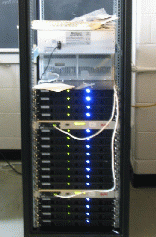
|
We originally parallelized our solver in the Cactus environment using the
department's first small cluster (left image). Test runs showed that we
can easily achieve for 3-D CFD, resolutions comparable to those achieved
in 2-D on serial machines, with run times of only days. An increase in
resolution x3, leads to a dramatic increase in our ability to capture
significant structure, and the same resources can be used to study the
development of instability in flows of length many hundreds of jet-radii,
at the current resolution. This could be used, for example, to address
the issue of jet flow heating of cooling cores (right image).
This code is currently being used on much larger, more modern clusters, to explore the advection of random magnetic field using the technique pioneered by Matthews & Scheuer (1990). |
ANIMATION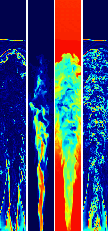
|
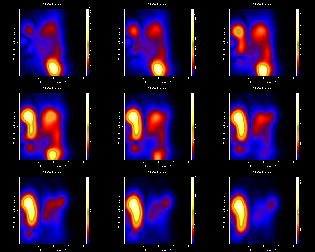 Participants:
Participants:
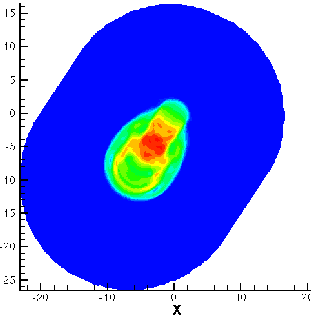 Imaging Simulated Relativistic Radio Jets (Swift, Ph. D. Thesis,
2002) presents flux maps of simulated relativistic jets. 2-D jets are
examined at three angles of view, both with and without accounting for
time-delay effects. Evolutionary sequences show that a) mildly relativistic
jets show complex radio structure, reflective of their internal hydrodynamics
even at small angles of view, and evolve more complex forms over time, b)
highly relativistic jets show little structure from any angle of view and
do not evolve into substantially more complex forms. It was found that
for mildly relativistic jets the radio core arises from Kelvin-Helmholtz
instabilities occurring near the axis of flow, while the extended emission
is a manifestation of the bow shock. Also, time-delay effects have a major
impact on the jet's radio morphology. Three 3-D jets were examined;
a perturbed slow jet, a precessing faster jet, and a deflected highly
relativistic jet. For the perturbed and precessing jet the underlying
hydrodynamics can be discerned at high angles of view to the axis of flow
in alternating `hot spots' on opposite side of the axis of flow, but the
jets are much less intense than their 2-D counterparts at all angles,
due to the lack of K-H instabilities in the high boost center of the jet.
Features in the maps of the deflected jet, however, do not bear a simple
relation to features seen in the hydrodynamics.
Imaging Simulated Relativistic Radio Jets (Swift, Ph. D. Thesis,
2002) presents flux maps of simulated relativistic jets. 2-D jets are
examined at three angles of view, both with and without accounting for
time-delay effects. Evolutionary sequences show that a) mildly relativistic
jets show complex radio structure, reflective of their internal hydrodynamics
even at small angles of view, and evolve more complex forms over time, b)
highly relativistic jets show little structure from any angle of view and
do not evolve into substantially more complex forms. It was found that
for mildly relativistic jets the radio core arises from Kelvin-Helmholtz
instabilities occurring near the axis of flow, while the extended emission
is a manifestation of the bow shock. Also, time-delay effects have a major
impact on the jet's radio morphology. Three 3-D jets were examined;
a perturbed slow jet, a precessing faster jet, and a deflected highly
relativistic jet. For the perturbed and precessing jet the underlying
hydrodynamics can be discerned at high angles of view to the axis of flow
in alternating `hot spots' on opposite side of the axis of flow, but the
jets are much less intense than their 2-D counterparts at all angles,
due to the lack of K-H instabilities in the high boost center of the jet.
Features in the maps of the deflected jet, however, do not bear a simple
relation to features seen in the hydrodynamics.
A small gallery of movies from the transfer calculations:
Movies are available on avi/mpg format. The former is better quality.
|
A UMRAO
program is in progress, designed to follow the spectral evolution
in total flux density and linear polarization at centimeter band during
gamma ray flaring observed by the
Fermi Gamma-ray Space Telescope , with the goal of identifying
physical conditions in the radio jet during these events. Information
on source structure comes from complementary VLBI imaging from the MOJAVE and Boston University
programs. Radio-band outbursts temporally associated with gamma-ray
flares and showing the signature of shocks are being modeled with a newly
developed transfer code.
In Oblique Shocks As The Origin Of Radio To Gamma-ray Variability In Active Galactic Nuclei the `shock in jet' model for cm-waveband blazar variability is revisited, allowing for arbitrary shock orientation with respect to the jet flow direction, and both random and ordered magnetic field. It is shown that oblique shocks can explain events with swings in polarization position angle much less than the 90 degrees associated with transverse structures, while retaining the general characteristics of outbursts, including spectral behavior and level of peak percentage polarization. Models dominated by a force-free, minimum energy magnetic field configuration (essentially helical) display a shallow rise in percentage polarization and frequency dependent swing in polarization position angle not in agreement with the results of single-dish monitoring observations, implying that the field is predominantly random in the quiescent state. Outbursts well-explained by the `shock in jet' model are present during gamma-ray flaring in several sources, supporting the idea that shock events are responsible for activity from the radio to gamma-ray bands. |
ANIMATION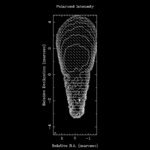
|

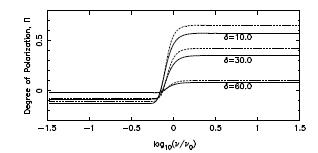 Participants:
Participants:

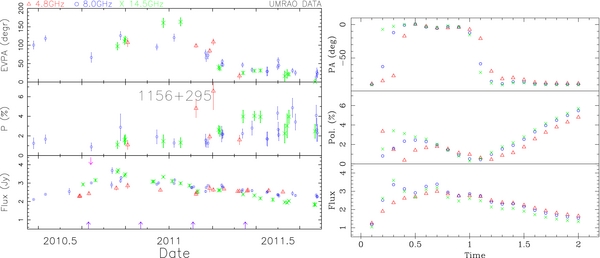 In Constraining
the Physical Conditions in the Jets of γ-Ray Flaring Blazars Using
Centimeter-band Polarimetry and Radiative Transfer Simulations. I. Data
and Models for 0420-014, OJ 287, and 1156+295 we describe how,
to investigate parsec-scale jet flow conditions during GeV γ-ray flares
detected by the Fermi Large Angle Telescope, we obtained centimeter-band
total flux density and linear polarization monitoring observations from
2009.5 through 2012.5 with the 26 m Michigan radio telescope for a sample of
core-dominated blazars. We use these data to constrain radiative transfer
simulations incorporating propagating shocks oriented at an arbitrary
angle to the flow direction in order to set limits on the jet flow and
shock parameters during flares temporally associated with γ-ray flares in
0420–014, OJ 287, and 1156+295; these active galactic nuclei exhibited the
expected signature of shocks in the linear polarization data. Both the number
of shocks comprising an individual radio outburst (3 and 4) and the range
of the compression ratios of the individual shocks (0.5-0.8) are similar in
all three sources; the shocks are found to be forward-moving with respect
to the flow. While simulations incorporating transverse shocks provide good
fits for 0420–014 and 1156+295, oblique shocks are required for modeling
the OJ 287 outburst, and an unusually low value of the low-energy cutoff
of the radiating particles' energy distribution is also identified. Our
derived viewing angles and shock speeds are consistent with independent
Very Long Baseline Array results. While a random component dominates the
jet magnetic field, as evidenced by the low fractional linear polarization,
to reproduce the observed spectral character requires that a significant
fraction of the magnetic field energy is in an ordered axial component. Both
straight and low pitch angle helical field lines are viable scenarios.
In Constraining
the Physical Conditions in the Jets of γ-Ray Flaring Blazars Using
Centimeter-band Polarimetry and Radiative Transfer Simulations. I. Data
and Models for 0420-014, OJ 287, and 1156+295 we describe how,
to investigate parsec-scale jet flow conditions during GeV γ-ray flares
detected by the Fermi Large Angle Telescope, we obtained centimeter-band
total flux density and linear polarization monitoring observations from
2009.5 through 2012.5 with the 26 m Michigan radio telescope for a sample of
core-dominated blazars. We use these data to constrain radiative transfer
simulations incorporating propagating shocks oriented at an arbitrary
angle to the flow direction in order to set limits on the jet flow and
shock parameters during flares temporally associated with γ-ray flares in
0420–014, OJ 287, and 1156+295; these active galactic nuclei exhibited the
expected signature of shocks in the linear polarization data. Both the number
of shocks comprising an individual radio outburst (3 and 4) and the range
of the compression ratios of the individual shocks (0.5-0.8) are similar in
all three sources; the shocks are found to be forward-moving with respect
to the flow. While simulations incorporating transverse shocks provide good
fits for 0420–014 and 1156+295, oblique shocks are required for modeling
the OJ 287 outburst, and an unusually low value of the low-energy cutoff
of the radiating particles' energy distribution is also identified. Our
derived viewing angles and shock speeds are consistent with independent
Very Long Baseline Array results. While a random component dominates the
jet magnetic field, as evidenced by the low fractional linear polarization,
to reproduce the observed spectral character requires that a significant
fraction of the magnetic field energy is in an ordered axial component. Both
straight and low pitch angle helical field lines are viable scenarios. Participants:
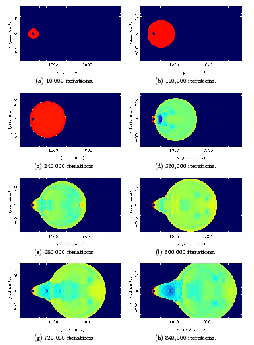 Probing the Depths: Relativistic, Hydrodynamic Simulations and X-ray
Observations of Pulsar Wind Nebulae (Bernstein, Ph. D. Thesis, 2008);
JPB writes:
Probing the Depths: Relativistic, Hydrodynamic Simulations and X-ray
Observations of Pulsar Wind Nebulae (Bernstein, Ph. D. Thesis, 2008);
JPB writes:
I have undertaken a joint computational and observational study of the interaction of a light, relativistic pulsar wind with a dense, ambient medium. Such a scenario has been suggested as the origin of asymmetric pulsar wind nebulae (PWNe). I present an analysis of data collected by the Chandra X-ray Observatory on the supernova remnant (SNR) MSH11-62. I show that the spectrum of the central region above 2 keV is dominated by non-thermal emission consistent with the presence of a pulsar wind nebula (PWN). The spatial and spectral analysis strongly suggests the presence of a compact object at the center of the nebula with an inferred spin-down energy sufficient to rotationally power the nebula. The asymmetry of the nebula strongly suggests that it has been crushed by the SNR reverse shock and the nebula and SNR are consistent with being in pressure equilibrium. Thus, this observation provides evidence that, in this case, the density distribution of the interstellar medium has had a dynamical effect on the morphology of the SNR/PWN system.
Another scenario wherein the ambient medium influences PWNe morphology arises when the pulsar's space velocity is supersonic with respect to the ambient sound speed. In order to study such a system, I have applied an existing adaptive-mesh, axisymmetric, relativistic hydrodynamic code to the simulation of the interaction of a relativistic pulsar wind with the slow, dense ambient flow setup by the space motion of the pulsar. I discuss simulations showing that this interaction can give rise to asymmetry reminiscent of the Guitar nebula leading to the formation of a relativistic backflow harboring a series of internal shockwaves. The shockwaves provide thermalized energy that is available for the continued inflation of the PWN bubble. In turn, the bubble enhances the asymmetry, thereby providing positive feedback to the backflow. Further, I present the first results from an extension of the model to study the shock acceleration, and subsequent synchrotron cooling, of particles advected by the flow. The new module may be used to compute models of synchrotron emissivity and to provide an energy sink, allowing for the exploration of the role of cooling on the flow dynamics.
Technical details and first results have been published as Refining a relativistic, hydrodynamic solver: admitting ultra-relativistic flows
This work has been majority supported by NASA Graduate Student Researchers Program grant number NGT5-159 with funding from Rob Petre of NASA/Goddard Space Flight Center.
| See Superluminal Magnetic Movies at the Brandeis University page. |
For very high temperature stimulation, not simulation:

|